|
Home \ Science Highlights ALMA Taiwan \ Science Goals
Window of ALMA Observations:
ALMA operates at wavelength bands spanning from the range between 9mm and 0.35mm, namely millimeter to submillimeter wavelengths. Since the bulk of the baryonic matter in the universe is cold, with a temperature of about 10K, the peak of its black body radiation lies in the far infrared. From the ground, the mm/submm wavelengths are as close as we can get to this radiation peak, thereby providing the highest sensitivity to study the sources of this radiation throughout the universe.
ALMA Science Goals:
With its unprecedented combination of sensitivity, angular resolution, spectral resolution and imaging fidelity, ALMA was designed to achieve the three top science goals :
- Detect spectral line emission from CO or CII in a normal galaxy like the Milky Way at a redshift of z = 3, in less than 24 hours of observation.
Because of the cosmological redshift, the blackbody spectrum of a distant galaxy will continue to shift towards longer wavelengths. This K-correction means that on the Rayleigh-Jeans side of the blackbody spectrum, at mm and submm wavelengths, the decreasing flux of a distant and receding galaxy is compensated by the rising spectrum of the blackbody spectrum. This is in contrast to what is seen in the optical world, where the optical wavelengths are probing the other side of the blackbody spectrum. ALMA will therefore provide a very important tool for seeing the structure and evolution of the universe at high redshifts, especially with regards to galaxy formation and star formation in the early epochs.
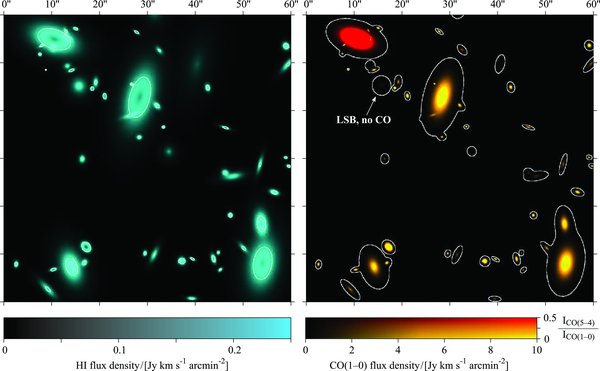 Obreschkow et. al. (2009) made simulations of CO and HI emission at high redshifts.
Obreschkow et. al. (2009) made simulations of CO and HI emission at high redshifts.
This image shows the integrated line emission of CO (1-0) in the right panel and HI
in the left one, for z=1.0-1.1 in 1 arcmin2. For CO, the colors represent the ratio
Ico(5-4)/Ico(1-0). The white contours around HI sources represent iso-density
curves of CO at 50 percent level of the full CO density scale and vise versa.
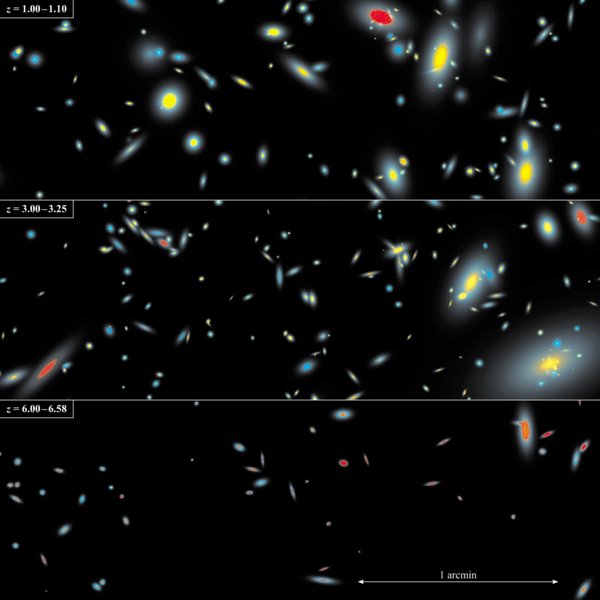 In this figure the description of the colors is the same as in the previous figure. In this
In this figure the description of the colors is the same as in the previous figure. In this
case the field of view is 3 x 1 arcmin2. The flux scales are 10 times smaller at
z = 3 and 100 times smaller at z = 6. Reference: ApJ, 2009, 703, 1890.
- Image the gas kinematics in protostars and in protoplanetary disks around young Sun-like stars at a distance of the nearest star-forming clouds.
In the past decade, great progress has been made in detecting planets outside of the solar system. Reflex motions on the stars detected in the optical with spectra, as well as direct transit measurements, revealed the presence of giant planets in very close orbits to the stars. Submillimeter imaging, on the other hand, has the advantage in being able to detect and resolve the distribution of the dust in the disk, where structures may indicate an underlying body. HST observations have shown disk like structures with solar system sizescales projected against bright nebular emission. Sometimes, a bright source is projected in the center of such disks as might be expected for an embedded star. The advantage is that submm observations can measure the dust content as well as the motions within such disks. With ALMA, sensitivity and resolution will be greatly improved, so that not only proto-planetary disks can be studied, but also the so called debris disks which are left behind after planets have formed. The structure and motions within such debris disks will be important indicators of the gravitational effects of the underlying planetary bodies which are too faint to detect directly.
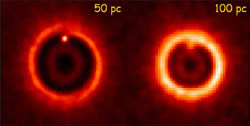 A simulation (Wolf & D'Angelo 2005) of ALMA observations at 950 GHz of a disc showing an
A simulation (Wolf & D'Angelo 2005) of ALMA observations at 950 GHz of a disc showing an
embedded protoplanet of 1 Jupiter Mass around a 0.5 Solar Mass star (orbital radius: 5AU).
The assumed distance is 50 pc or 100 pc as labeled. The disc mass is set to that
of the Butterfly Star (IRAS 04302+2247) in Taurus. Note the reproduced shape
of the spiral wave near the planet and the slightly shadowed region behind
the planet in the left image. Image courtesy S. Wolf.
 Cossins et. al. (2010) reported simulated observations of massive circumstellar discs
Cossins et. al. (2010) reported simulated observations of massive circumstellar discs
(0.2 Solar masses) orbiting a 1 Solar mass star, using ALMA. The image shows the optical
depth in logarithmic scale for 45 GHz (left), 345 GHz (center) and 870 GHz (right).
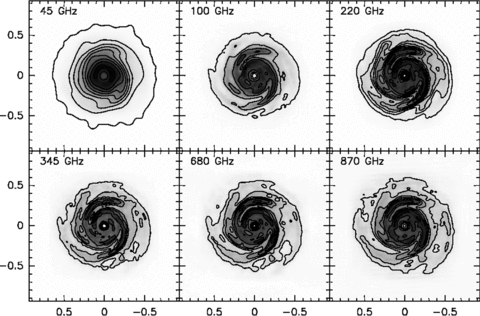 For the same case, this images shows ALMA simulations of a 2-hours transit
For the same case, this images shows ALMA simulations of a 2-hours transit
observations for a source at 50 pc of distance. The scale marks are arcseconds.
Contours start at 0.01 and are spaced by 0.08 mJy beam-1 at 45 GHz, start at 0.08 and
are spaced by 0.2 mJy beam-1 at 100 GHz, start at 0.5 and are spaced by 0.5 mJy beam-1
at 220 GHz, start at 0.8 and are spaced by 0.8 mJy beam-1 at 345 GHz, start at 2
and are spaced by 2 mJy beam-1 at 680 GHz, start at 4 and are spaced
by 4 mJy beam-1 at 870 GHz. Reference: MNRAS, 2010, 407, 181.
- Provide precise images at an angular resolution of 0.1 arcsec.
In addition, interferometry at mm/submm wavelengths would allows us not only to tackle the above scientific goals, but also to resolve the dust continuum emission from forming stars, protoplanetary disks, solar system bodies, galactic nuclei, circumstellar outflows and winds, and forming galaxies at the edge of the universe. An abundance of atomic and molecular spectral lines in the submm band, due to the dependence of the Einstein A coefficient on ν3, provide kinematic and chemical probes over a wide range of excitation conditions. Moreover, full polarization capabilities allow the strength and orientation of magnetic fields to be studied.
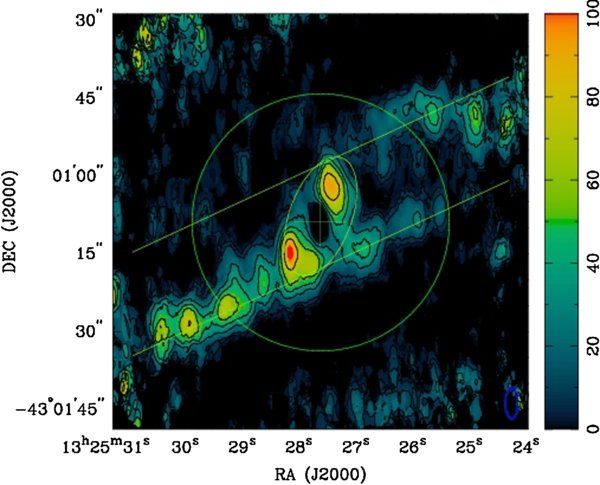 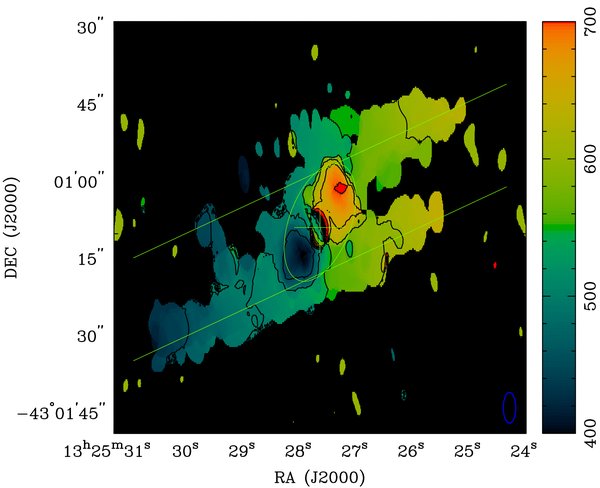 Torus/Jets in AGNs are one of the interesting cases to study with high resolution observations.
Torus/Jets in AGNs are one of the interesting cases to study with high resolution observations.
Espada et. al. (2009) reported CO (2-1) SMA observations of Centaurus A. The left panel
shows the distribution of the emission in the sky and the right panel shows the velocities
of that emission. The cross marks the position of the black hole, the ellipse the
location of the resolved inner circumnuclear disk, and the two parallel lines
the location of the molecular gas associated with the dust lane.
Reference: ApJ, 2009, 695, 116.
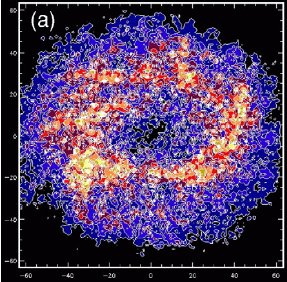 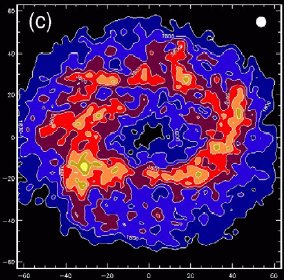 Simulations for observations with CO (2-1) were reported by Maiolino (2008), for one
Simulations for observations with CO (2-1) were reported by Maiolino (2008), for one
of the most studied AGN, NGC 1068. The figure shows intensity emission using the
extended torus AGN model of Wada & Tomisaka (2005). The panel a) corresponds
to the map predicted by the model, while the panel c) shows the map expected
for an ALMA observation. The size of the torus is supposed to be 64 pc
in diameter. Reference: New Astronomy Reviews, 2008, 52, 357.
Solar System Studies. With ALMA, solar system bodies will be studied both in the continuum and in spectral lines. Planetary atmospheres can be studied spectroscopically in detail. For example, the weather patterns on the planets can be resolved both spatially and kinematically. Even volcanic eruption on Io can be detected and mapped with ALMA. Molecular studies of the volcanic activity will be possible. Kuiper Belt Objects and comets will also be studied.
Evolved Stars. In late type stars, circumstellar envelopes are ejected. These envelopes are rich in dust and molecules. Because of the chemical and excitation variations within these envelopes, studies with a variety of spectral lines will be able to peel back such envelopes like layers of an onion. ALMA will be able to study such envelopes with much greater detail, such as their structure, kinematics, and molecular abundances.
Circumstellar Jets. One of the great discoveries in star formation studies during the last two decades has been the recognition that molecular outflows are an important and ubiquitous phase in forming a star. Theories have suggested that inflowing gas in a disk eventually eject excess angular momentum along magnetic field lines along the pole of the disk. Material which successfully loses their angular momentum would continue inwards, while the rest of the material would be returned to the ISM via the outflows. While the general structure of outflows has been defined by observations on the large scales, the structure and excitation in the inner parts of the disk have been difficult to study. With ALMA we expect to study the kinematics of the central parts of jets at AU resolutions.
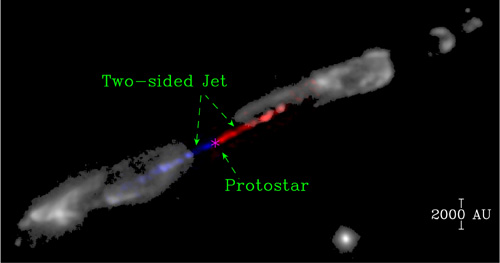 The two-sided (red for receding and blue for approaching sides) jet HH 211
The two-sided (red for receding and blue for approaching sides) jet HH 211
observed with the SMA (Lee et al. 2007). The gray image shows
the shock emission produced by the jet (Hirano et al. 2006).
 An artist's conception showing a supersonic jet ejected from a
An artist's conception showing a supersonic jet ejected from a
disk around a protostar (Image Credit: Change Y.C. Tsai/ASIAA).
Magnetic Field Structures in Star Forming Regions. Polarization studies in the submillimeter wavelengths have shown that the dust emission is polarized. In contrast to optical and infrared studies where polarization is from reflection and scattering, submm studies directly see the emission from the dust grains. Hence polarization implies that the dust grains are elongated and aligned. The alignment mechanism is presumably the magnetic field and from the alignment of the grains, which is perpendicular to the magnetic field, we can deduce the field directions across the line of sight. ALMA will provide greater sensitivity and resolution, which would greatly improve our ability to study for a variety of sources and on much finer spatial scales the magnetic field structures which play crucial role in determining the star formation processes.
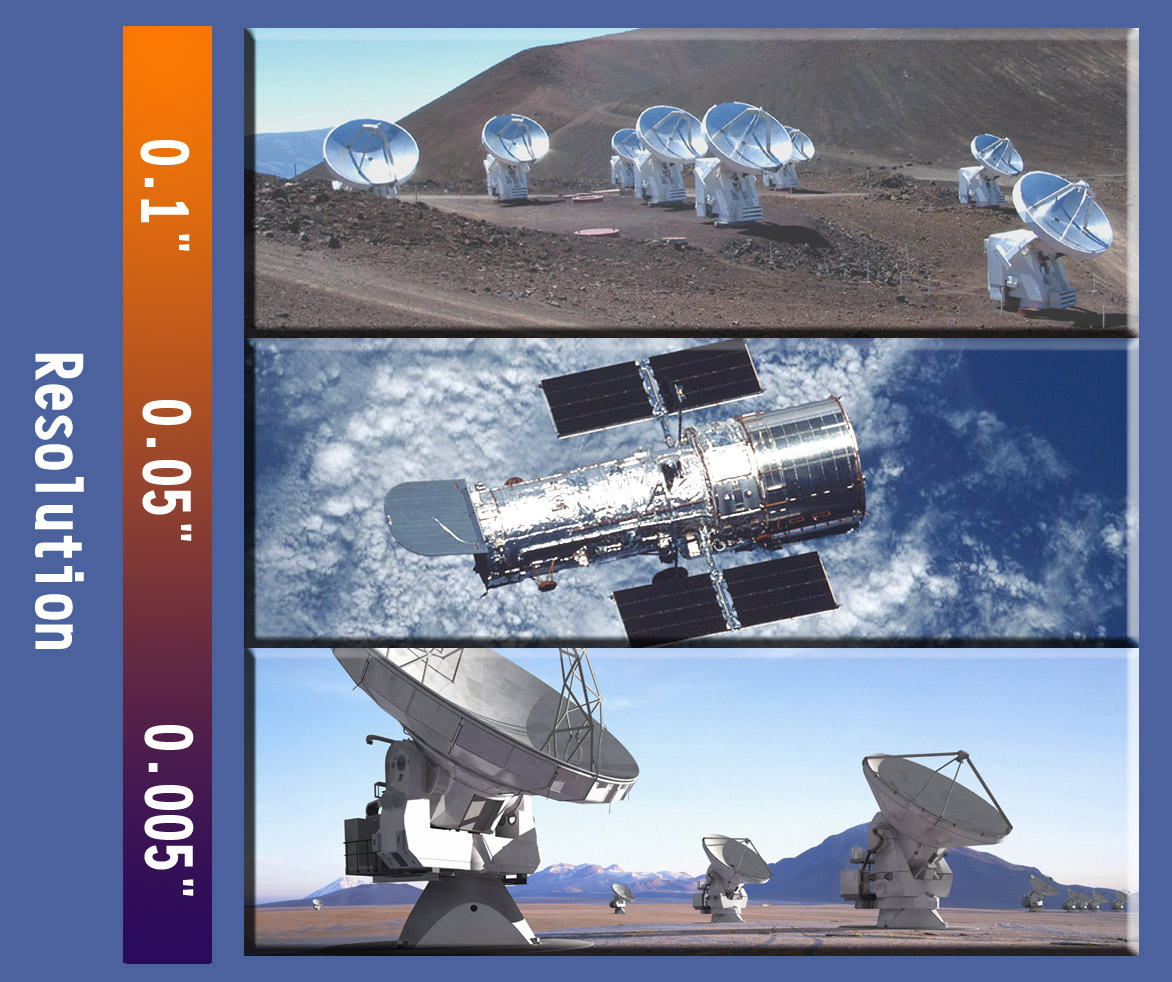 The comparison of the resolutions of "Giant Eyes": SMA, HST and ALMA
The comparison of the resolutions of "Giant Eyes": SMA, HST and ALMA
(from top to bottom).
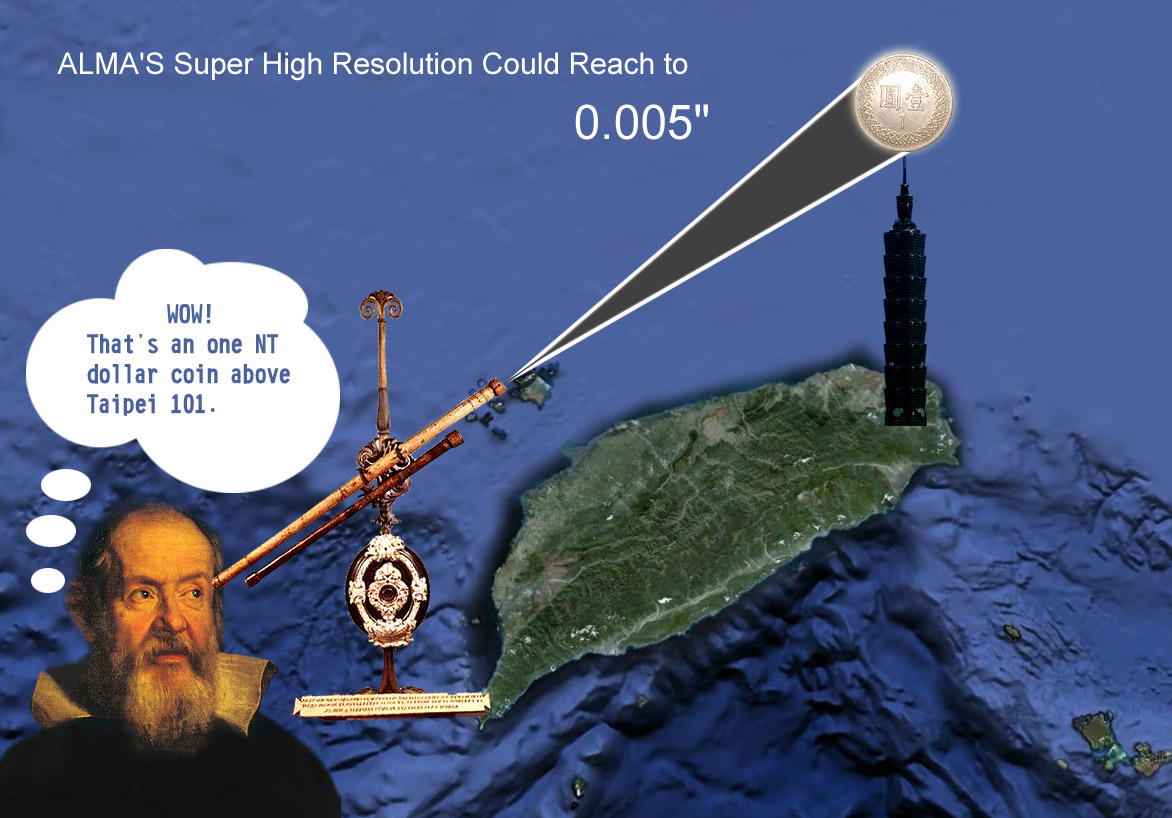 A cartoon to show the resolution of ALMA: even from the southest point
A cartoon to show the resolution of ALMA: even from the southest point
of Taiwan, you can recongnize a 1 NT doller coin above Taipei 101.
|
 asiaa.sinica.edu.tw | Privacy and Security Policy
asiaa.sinica.edu.tw | Privacy and Security Policy















